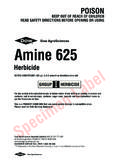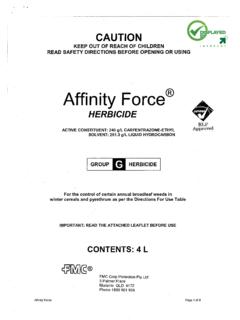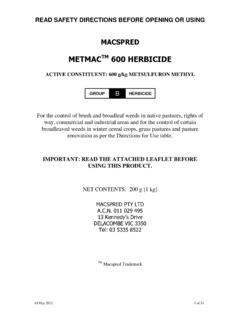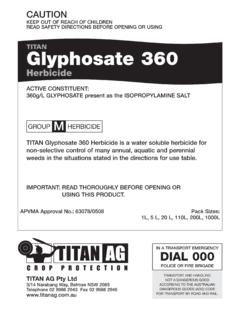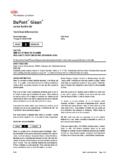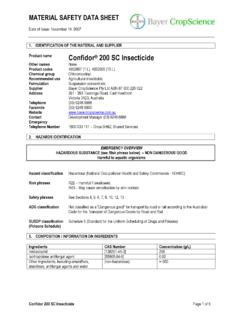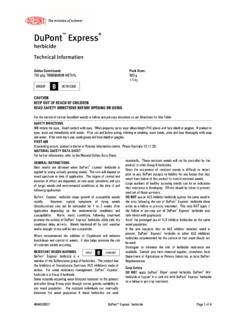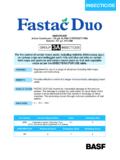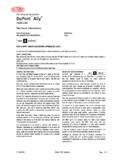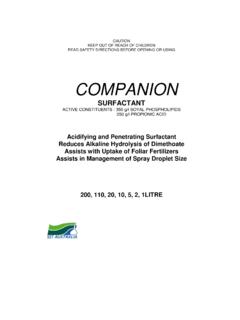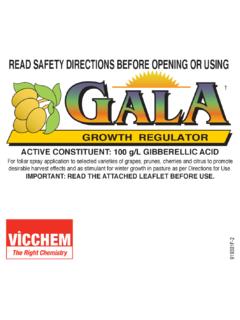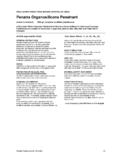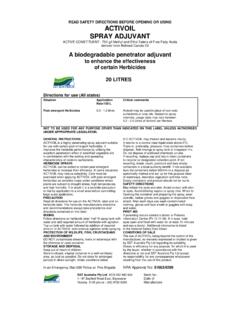Transcription of KEEP OUT OF REACH OF CHILDREN READ SAFETY …
1 CAUTION KEEP OUT OF REACH OF CHILDREN read SAFETY directions before opening OR USING Roundup PowerMAX Herbicide by Monsanto ACTIVE CONSTITUENT: 540 g/L GLYPHOSATE (present as the potassium salt) GROUP M HERBICIDE Non-selective herbicide for the control of many annual and perennial weeds. read COMPLETE directions FOR USE before USING THIS PRODUCT. Roundup PowerMAX is a registered trademark of Monsanto Technology LLC used under licence by Nufarm Australia Limited directions FOR USE RESTRAINT DO NOT disturb weeds by cultivation, sowing or grazing for six hours of daylight following treatment of annual weeds and seven days for perennial weeds to ensure herbicide absorption, unless specified otherwise in critical comments.
2 CONSERVATION TILLAGE SITUATION WEEDS CONTROLLED RATE CRITICAL COMMENTS SOUTHERN AUSTRALIA Prior to sowing a crop or pasture with FULL SOIL DISTURBANCE by cultivation or sowing with a tyned implement Barley grass, Brome grass, Volunteer cereals, Wild oats 340-660mL/ha pre-tillering 660-840mL/ha post- tillering Rate Selection Use higher rates for advanced weed growth or when treating under cold/overcast conditions. Cultivation or planting may proceed from 1 hour of daylight after application to seedling annual weeds if a satisfactory seedbed can be created for crop germination and seedling establishment.
3 Silver grass When treating dense infestations of Silver grass, add Wetter TX and use water volumes of 70L/ha or more and FINE to MEDIUM spray quality to improve coverage. Perennial Weeds. Roundup PowerMAX will provide seasonal control and reduction in plant numbers. Control of Skeleton weed requires addition of full soil disturbance at planting. In Tasmania, for perennial weeds use 1-2L/ha. Annual phalaris, Annual ryegrass, Silver grass, Winter grass 660-840mL/ha pre-tillering 840mL-1L/ha post- tillering Calomba daisy, Capeweed, Doublegee/Spiny emex, Fumitory, Volunteer lupins, Volunteer peas 340-660mL/ha less than 8cm dia/height 660mL-1L/ha greater than 8cm dia/height Amsinckia, Dock (seedling)
4 , Paterson s curse, Saffron thistle, Scotch thistle, Spear thistle, Variegated thistle, Wild turnip 660-840mL/ha less than 12cm dia/height 840mL-1L/ha greater than 12cm dia/height Perennial phalaris, Skeleton weed, Sorrel, 1L APVMA Approval No.: 55687/ 52804 Roundup PowerMAX Herbicide by Monsanto Approved: 23 Mar 2011 Page 2 SITUATION WEEDS CONTROLLED RATE CRITICAL COMMENTS SOUTHERN AUSTRALIA To commence a fallow OR Prior to planting a crop or pasture with an implement that gives MINIMAL SOIL DISTURBANCE or prior to surface seeding of pastures Barley grass, Canary grass, Wild oats, Volunteer cereals 660mL-1L/ha Rate Selection Use the lower rate on young weeds.
5 Increase to the higher rate where grasses REACH full tillering or where broadleaf weeds commence stem elongation or budding. Use higher rates in Spring and under cold conditions. In Tasmania use 1-2L/ha with the higher rate for control of perennial weeds. Pasture or Crop Establishment DO NOT sow into excessive trash. Excessive plant residues may be removed by grazing after treatment. Planting may proceed from 1 hour of daylight after application to seedling annual weeds if a satisfactory seedbed can be created for crop germination and seedling establishment.
6 Aerial (or Surface) Seeding Delay seeding until trash level is reduced to allow for satisfactory placement of broadcast seed on the soil surface. Bathurst burr For mature weeds use the higher rate. Bent grass Use a rate of Apply in late Spring following initiation of seed-head emergence. Follow up with full disturbance with a tyned implement 10-21 days after spraying. Couch, Kikuyu, Paspalum Use the higher rate on dense infestations. Apply sequential treatments during Summer and Autumn. Repeat applications will be required for full control.
7 For improved control, use in conjunction with cultivation. Kikuyu, Paspalum Use the low rate for suppression, the high rate for control. Dock, Flatweed Use the maximum rate for full control. Hoary cress. Treat from late rosette to early flowering. Silver grass When treating dense infestations of Silver grass, add Wetter TX and use water volumes of 70L/ha or more and FINE to MEDIUM spray quality to improve coverage. Soursob Use at a rate of 1L/ha. Treat at tuber exhaustion. Annual ryegrass, Brome grass, Capeweed, Paterson s curse, Saffron thistle, Scotch thistle, Silver grass, Soursob, Spear thistle, Variegated thistle, Wild mustard, Wild radish, Wild turnip, Winter grass Bent grass, Bathurst Burr, Couch, Dock, Erodium, Flatweed, Hoary Cress, Kikuyu, Plantain, Paspalum, Perennial phalaris, Sorrel, Sub.
8 Clover, Yorkshire fog Poa tussock Timing Treat fresh regrowth (at least 14 days after heavy grazing) after Autumn break and before onset of heavy frosts. Sowing may start from 14 days after spraying. Pasture Topping Annual ryegrass 300-680mL/ha Remove livestock prior to application to allow even regrowth. Use lower rate if grasses are flowering and higher rate if at the milky dough stage. Apply to Capeweed and Calomba daisy at flowering. DO NOT add Wetter TX. DO NOT apply to clover or medic crops intended for seed production.
9 Barley grass, Brome grass, Capeweed, Silver grass 200-300mL/ha Calomba daisy 300mL/ha Seed-head Suppression Bent grass 240-420mL/ha Apply treatments late October to late November, before seedheads have emerged. Add Wetter TX. Use the higher rate where growth is excessive. Graze hard after spraying. SOUTHERN AUSTRALIA NSW, ACT, Vic, Tas only For control/ suppression prior to establishing crops or improved pasture species Serrated tussock Apply to actively growing and stress free plants. Best results May to October.
10 Application: Boom spray volume of 70L/ha or more is recommended to improve plant coverage. Also see Aerial Equipment. Surfactants: Addition of 200mL of Wetter TX to 100L of spraying solution may improve control of Serrated tussock. Site Preparation: Burning of Serrated tussock 10-12 months before spraying or slashing/heavy grazing (cell grazing) 2 weeks before spraying is essential for good results (Note: Serrated tussock is almost indigestible and prolonged exposure can lead to starvation and death of stock). Rates: Use lower rate on Serrated tussock regrowth after burning (no residual dead foliage).
